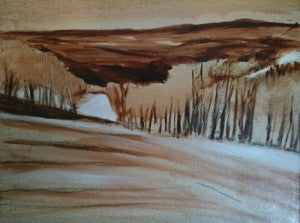
From my sunny San Francisco Pacific
beach studio I’m revisiting the snowy mountains surrounding
Montage Deer Valley.
I’m excited about a new painting technique that I’m experimenting with where I first establish the values before I develop the color.
Representational paintings are illusions of reality. Illusions that are created by employing a number of different basic elements.
These visual elements are considered in about this order:
- Line
- Shape
- Scale
- Value
- Direction
- Color
So in this study above, if I’m in the groove, I’m not thinking “trees” or “distant mountains”, I’m thinking shape and value.
I’m defining this image by studying its most basic elements. What is the darkest dark? What is the lightest light?
If I pay attention to this intuitive recipe, and I feel it, rather than think it, and the painting works. If I get distracted, it's over.
Feeling it is key. Why? Feeling, not thinking, is what
the artist, and therefore the viewer, responds to.
Even if we can’t put to our feelings into words, it’s feeling that makes us become enthralled with a painting, playing a song, or turning the pages of the novel.
Of course we all feel and respond differently. So art is in the eye of the beholder and the subject of tremendous debate. If you feel it, do you need another’s opinion to tell you so?
Art’s purpose is not simply to represent images, stories, or ideas. Art is meant to make us feel, which of course can lead to thinking.
However subtle or indescribable the feeling may be, we all know art when we feel it.
 From my sunny San Francisco Pacific beach studio I’m revisiting the snowy mountains surrounding Montage Deer Valley.
I’m excited about a new painting technique that I’m experimenting with where I first establish the values before I develop the color.
Representational paintings are illusions of reality. Illusions that are created by employing a number of different basic elements.
These visual elements are considered in about this order:
From my sunny San Francisco Pacific beach studio I’m revisiting the snowy mountains surrounding Montage Deer Valley.
I’m excited about a new painting technique that I’m experimenting with where I first establish the values before I develop the color.
Representational paintings are illusions of reality. Illusions that are created by employing a number of different basic elements.
These visual elements are considered in about this order:




